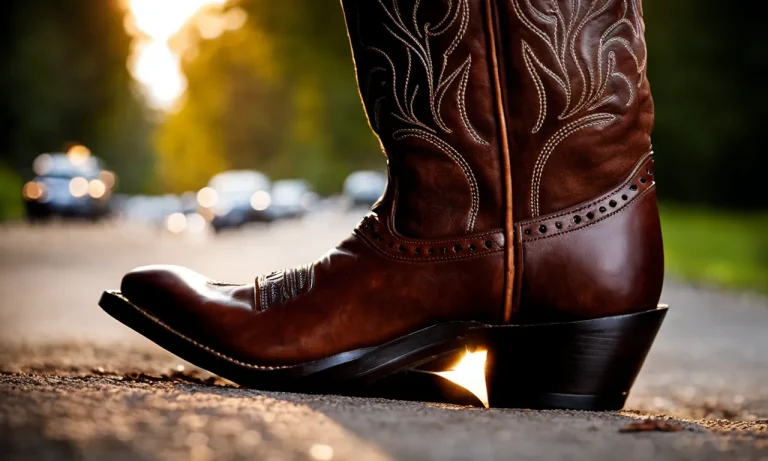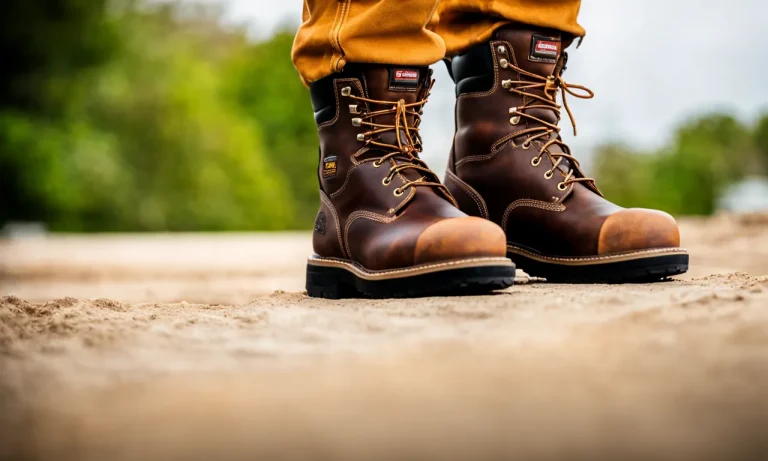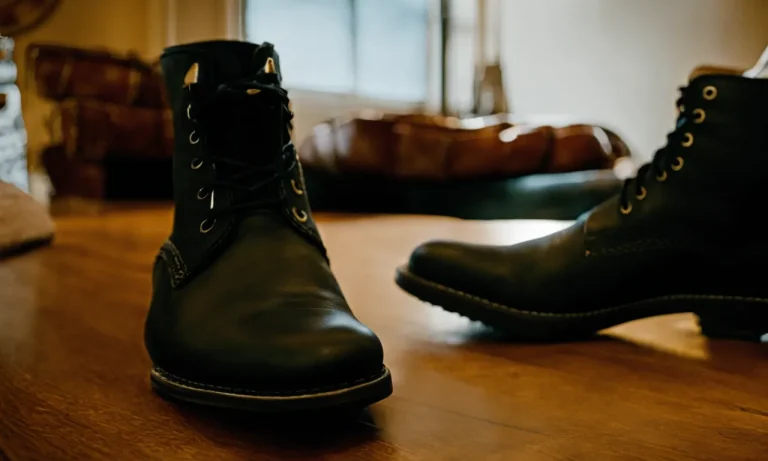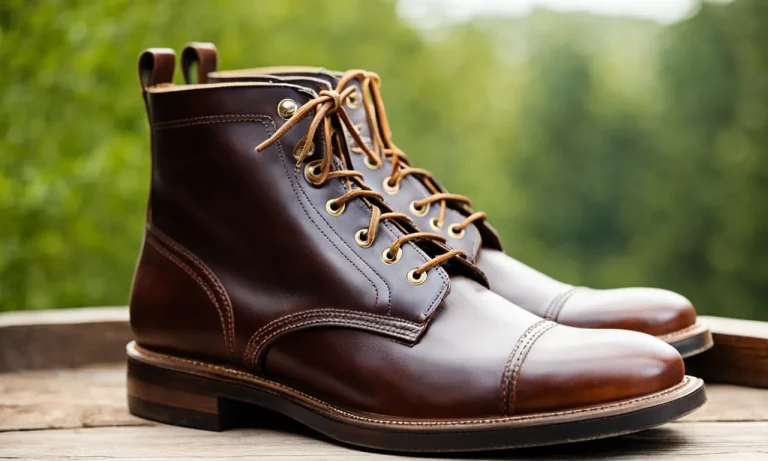If you want to give your reliable rubber boots a facelift or customize them with your own unique style, painting them is a fun DIY project that can completely transform their look. But what kind of paint works best on rubber boots? And what steps do you need to take to ensure the paint job lasts?
This comprehensive guide has all the answers.
If you’re short on time, here’s a quick answer: Use a high-flexible paint made for rubber, plastic and vinyl, properly prepare the surface, apply 2-3 thin coats letting each dry in between, and seal with a clear topcoat for maximum durability and weather resistance.
Choosing the Right Paint for Rubber Boots
When it comes to painting rubber boots, it is important to choose the right type of paint that will adhere well to the rubber surface and provide long-lasting results. Here are three popular options to consider:
Acrylic Craft Paint
Acrylic craft paint is a versatile option for painting rubber boots. It is readily available in various colors, dries quickly, and provides a smooth finish. Additionally, it offers good adhesion to rubber surfaces and is generally affordable.
However, it is important to note that acrylic craft paint may not be as durable as other options and may require a sealant to protect the paint from chipping or peeling over time.
Latex Paint
Latex paint is another viable option for painting rubber boots. It is known for its durability and flexibility, which makes it suitable for rubber surfaces. Latex paint is available in a wide range of colors and finishes, allowing for creative customization.
One advantage of latex paint is that it is water-based, which means easy clean-up and low odor. However, it is important to ensure that the latex paint is compatible with rubber surfaces and to prepare the boots properly before applying the paint.
Rubber and Vinyl Paint
Specifically designed for rubber and vinyl surfaces, rubber and vinyl paint is an ideal choice for painting rubber boots. This type of paint provides excellent adhesion, flexibility, and durability. It is resistant to cracking, peeling, and fading, ensuring that the paint job will last for a long time.
Rubber and vinyl paint is available in a variety of colors and finishes, allowing for customization to suit individual preferences. It is important to follow the manufacturer’s instructions for proper application and to allow sufficient drying time.
Before painting your rubber boots, it is recommended to clean and dry them thoroughly. This will help the paint adhere better and ensure a more successful outcome. Additionally, consider using a primer specifically formulated for rubber surfaces to enhance the paint’s adhesion and longevity.
Remember, each type of paint has its own advantages and considerations, so it’s important to choose the one that suits your needs and preferences best. Experimenting with different paints and techniques can lead to unique and personalized results. Happy painting!
Preparing Rubber Boots for Painting
Cleaning the Surface
Before you start painting your rubber boots, it is essential to clean the surface thoroughly. Use a mild soap and water solution to remove any dirt, mud, or grime. Gently scrub the boots with a soft brush or sponge, making sure to reach all the nooks and crannies.
Rinse them well and allow them to dry completely before moving on to the next step. This step is crucial as it ensures that the paint adheres properly to the rubber surface.
Sanding the Rubber
Sanding the rubber surface of your boots helps to create a better bond between the paint and the material. Use a fine-grit sandpaper to lightly sand the entire surface of the boots. This will roughen up the rubber slightly, allowing the paint to adhere more effectively.
Be careful not to sand too aggressively, as this can damage the rubber. After sanding, wipe away any dust with a clean cloth or tack cloth.
Applying Primer
Priming your rubber boots is an essential step that helps the paint adhere and ensures a smoother and more durable finish. Choose a primer specifically designed for use on rubber surfaces. Apply a thin and even coat of primer to the boots, using a brush or a spray can.
Allow the primer to dry completely according to the manufacturer’s instructions. This step not only helps the paint adhere better but also provides a base for the color to appear more vibrant.
Remember, always follow the instructions on the paint and primer products you are using, as different brands may have specific guidelines. By properly preparing your rubber boots, you will create a solid foundation for a successful painting project that will help your boots look brand new and stylish!
Painting Techniques and Applying Paint
Brushes vs Spray Paint
When it comes to painting rubber boots, you have the option of using either brushes or spray paint. Both techniques have their advantages and it ultimately depends on your personal preference and the desired outcome.
Using brushes allows for more precision and control over the paint application, making it ideal for intricate designs or detailed patterns. On the other hand, spray paint can provide a more even and smooth finish, making it a great choice for covering larger areas quickly.
It is important to consider the type of paint you are using and follow the manufacturer’s instructions for application, as certain paints may be better suited for one technique over the other.
How Many Coats to Apply
The number of coats you apply when painting rubber boots can greatly affect the final result. In most cases, it is recommended to apply multiple thin coats rather than one thick coat. This allows for better adhesion and durability of the paint.
Start by applying a base coat to ensure good coverage and adhesion to the rubber surface. Once the base coat is dry, you can proceed with additional coats until you achieve the desired color and finish. It is important to allow each coat to dry completely before applying the next one.
This will prevent smudging or smearing of the paint and ensure a smooth and professional-looking finish.
Drying Time
The drying time of the paint on your rubber boots will depend on several factors, including the type of paint used and the environmental conditions. Generally, it is recommended to allow the paint to dry for at least 24 hours before wearing or handling the boots.
This will ensure that the paint has fully cured and hardened, providing a long-lasting and durable finish. Keep in mind that colder temperatures and high humidity can prolong the drying time, so it is best to choose a well-ventilated area with moderate temperatures for the painting process.
Additionally, if you are using multiple coats of paint, make sure each coat is completely dry before applying the next one to avoid any potential issues with the drying process.
For more information on painting techniques and tips, you can visit websites such as The Spruce Crafts or Artistro.
Sealing the Paint Job
Once you have finished painting your rubber boots and are happy with the design, it is important to seal the paint job to ensure its longevity. Sealing the paint will protect it from chipping, peeling, and fading, especially when exposed to outdoor elements.
Types of Sealants
There are several types of sealants that work well on painted rubber boots. One popular option is a clear acrylic sealer, which provides a protective coating without altering the appearance of the paint.
Another option is a waterproof sealant, which not only protects the paint but also adds an extra layer of water resistance.
It is important to choose a sealant that is compatible with the type of paint you used on your boots. Some sealants may react negatively with certain types of paint, causing the colors to bleed or fade.
It is always a good idea to test the sealant on a small, inconspicuous area of the boots before applying it to the entire surface.
Application Process
Before applying the sealant, make sure the painted boots are completely dry. Wipe away any dust or debris with a clean cloth. If there are any uneven or rough areas on the paint, gently sand them down with fine-grit sandpaper to create a smooth surface.
Next, follow the instructions on the sealant product for proper application. In most cases, you will need to shake the can well and hold it about 8-12 inches away from the boots. Apply the sealant in thin, even coats, making sure to cover the entire painted surface.
Allow each coat to dry completely before applying the next one.
Additional Tips
Here are some additional tips to ensure a successful seal on your painted rubber boots:
- Apply multiple coats: Applying multiple thin coats of sealant will provide better protection than a single thick coat.
- Avoid excessive heat: Keep the boots away from direct sunlight or high temperatures during the drying process, as this can cause the paint and sealant to bubble or crack.
- Store properly: After the sealant has dried completely, store your painted rubber boots in a cool, dry place to prevent any damage.
By sealing the paint job on your rubber boots, you can ensure that your unique design will last for a long time. Not only will this protect your artwork, but it will also prolong the life of the boots themselves.
So go ahead and get creative with your rubber boot painting, knowing that your hard work will be preserved for years to come!
Painting Design Ideas
Solid Colors
If you want a simple and elegant look for your rubber boots, painting them with solid colors is a great option. Whether you want to match them with your outfit or make a bold statement, solid colors can be a versatile choice.
You can go for classic colors like black, white, or brown, or experiment with vibrant hues like red, blue, or yellow. The key is to choose a high-quality paint that adheres well to rubber and won’t crack or peel off easily.
Patterns or Graphics
For those who want to add a touch of creativity and personality to their rubber boots, painting patterns or graphics is the way to go. You can unleash your artistic side and create unique designs such as polka dots, stripes, or floral patterns.
You can also try painting fun graphics like stars, hearts, or even your favorite cartoon characters. The possibilities are endless, and you can let your imagination run wild!
Ombre or Fading Color
If you’re looking for a trendy and eye-catching design, consider painting your rubber boots with an ombre or fading color effect. This technique involves blending two or more colors together to create a seamless gradient.
You can choose colors that complement each other or go for a bold and contrasting combination. To achieve the ombre effect, start with a light color at the top of the boots and gradually transition to a darker shade towards the bottom.
Stenciled Designs
Stenciled designs offer a way to achieve intricate and detailed artwork on your rubber boots. You can purchase pre-made stencils or create your own using adhesive vinyl or cardboard. From intricate patterns to intricate designs, stencils allow you to achieve professional-looking results with ease.
You can experiment with different shapes, symbols, or even quotes to make your boots truly unique. Just make sure to secure the stencil firmly on the boots and use a steady hand while painting to avoid smudging.
Conclusion
With the right supplies and techniques, you can stylishly transform your reliable rubber boots with a creative paint job. Just be sure to use flexible paint made for rubber, properly prepare the surface, apply thin even coats, and seal the finished product.
Your customized boots will be a wearable work of art!






